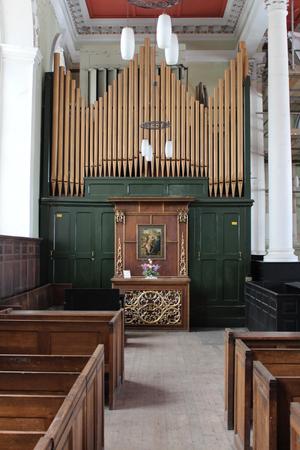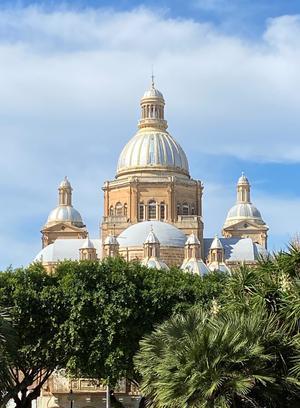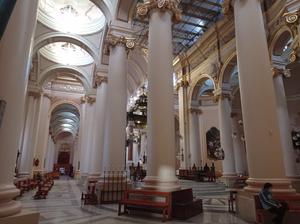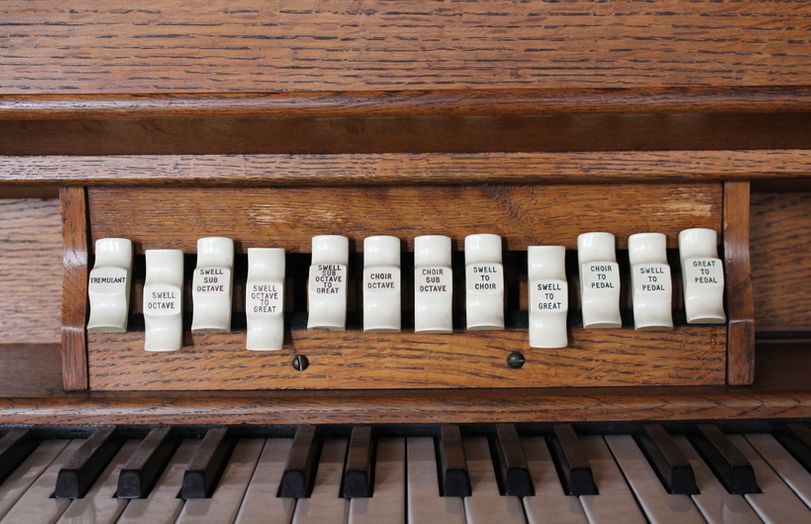Holy Trinity – The restoration and conservation journey of a Sunderland church and its organ
Holy Trinity has been in the care of the Churches Conservation Trust (CCT) since 1988. However until recently, the Grade I listed building, which is the oldest in Sunderland’s East End, has been on Historic England’s ‘at risk’ register. Now a £4.3million project to repair the grade I listed Georgian building is nearing completion and has included urgent and highly-skilled fabric building repair, such as historic brickwork and masonry, plastering and joinery, as well as sensitively equipping this space with up to date facilities.
The project is supported by the National Lottery Heritage Fund, Sunderland City Council and All Churches Trust, Garfield Weston, and other funders, individuals, supporters and donors. The primary purpose of the project is to ensure that this historic building is saved for future generations to enjoy.
The Holy Trinity Organ
Unfortunately, in 2017 due to increasing costs for the project, a Value Engineering (VE) cost-saving exercise was carried out and the organ was included, along with other items such as the sundials and refurbishment of Nave furniture. The reasoning was that the organ was not in regular use, the condition was deteriorating and urgent repair works to stop water ingress needed to be undertaken behind the organ casing in the North-East corner. It was agreed by everyone involved that saving the church building was the most pressing and important decision at this time. Our options, based on limited funds were to remove the organ to allow repairs, store the organ for the duration of the contract and return the casing and console only. We could not underwrite or raise any further funds to support the full restoration and return the organ as a working instrument.
We took professional advice from a number of recognised bodies including Historic England and CCT’s Conservation Committee represented by sector experts from across the UK. The consensus was that if CCT could not fund to keep it at Holy Trinity then efforts should be made to rehouse the organ as a whole instrument elsewhere.

Through our detailed conservation disposal policy process we followed the approved steps. We offered the organ internally to any other churches in our collection, then nationally to any interested parties including a listing on the IBO (The Institute of British Organ Building) and then finally internationally with Ladach Instruments, a leading specialist for selling and buying pipe organs on an international scale. Instrumente Ladach travelled to Sunderland to inspect and record a detailed report for the listing. The costs for the repair of the organ are deemed significant, see attached.
Working with the community
In October 2018, a Listed Building Consent (LBC) application to permanently remove the organ was made, as the project budget was not able to accommodate the reinstallation of the instrument. (See Appendix A Background to LBC application for organ) Due to the objections on the Sunderland City Council planning portal, CCT took the decision to withdraw the LBC application, to allow an opportunity to further consult with the local community, listen to concerns and explain the costs for repairing/reinstating the organ and the overall project aims and timescales.
In March 2019, two meetings were held to discuss the future of the organ. On March 3rd, CCT met with representatives of the Sunderland Save Our Heritage (SSOH) group, who had formed to campaign for the organ to be returned to the building. At that meeting, it was understood that the organ would need to be removed and stored to allow the necessary repairs to take place in that area of the church. CCT had an opportunity to clearly outline the project costs for the organ, the reason why the budget was not available to put the organ back and to talk with the group about the solutions to raising the funds to do this.
The result of the meeting was an agreed tiered approach, as follows:
1) SSOH agreed to undertake to raise the money to allow the organ to be put back in the building with minimal repairs to be partially usable and for safe maintenance access. This to be done within a 12 month period (May 2019 – May 2020)
IF this was not achieved:
2) The community (via SSOH) to provide funds or CCT to see if any project budget remaining (after major works) to extend the storage period (e.g. six months, length depends on what funds available) for fundraising efforts to continue to reach the target.
IF this was not achieved:
3) CCT will replace the organ casing and console so that the organ is represented in the space as part of the story of the building, and dispose of the interior mechanism.
However, after further consultation, we found that option 3 was not supported by either Historic England or BIOS.
On 11th March the public were invited to visit Holy Trinity where information about the organ and the project were displayed and CCT staff on hand to answer questions. This was followed by a formal public meeting in the evening, where the community were invited to take part in an open and transparent conversation around the application to remove the organ from the church and a discussion around the future of the organ.
A panel made up of CCT and SSOH representatives chaired by Archdeacon Revd Canon Bob Cooper, presented the tiered approach to the organ as agreed at the meeting on 3rd March. The floor was then opened up for the community to ask questions about the organ and major regeneration project.
Following this meeting, CCT were keen to work with SSOH and a Memorandum of Understanding (MOU) was developed, outlining this agreed approach. However, SSOH decided not to enter into an MOU with CCT instead deciding to continue to fundraise independently.
In November 2019, SSOH informed CCT that they had ceased to fundraise for the reinstallation of the organ. Due to the delay by the Charity Commission to provide them with a charity number and the increase in costs of the reinstallation provided by the organ builder once the instrument had been removed (See Appendix B Update organ costs breakdown 200227).
Resuming our progress
By June 2020 the CCT financial position had not changed in terms of the budget available for the organ, in fact with increasing costs due to the pandemic, budgets were put under further strain to support the repairs to the church fabric. CCT submitted an LBC application for the permanent removal of the organ, as it was now clear that having the whole instrument returned to the space would not be possible.
Permission was granted in August 2020 to permanently remove the organ from Holy Trinity, following this decision we set about looking for a new home. Through the CCT’s detailed Conservation Disposal Policy we followed the guidance of specialists by offering the organ to all CCT churches in our collection, local and regional churches through the Diocese, nationally to any interested parties including a listing on the IBO (The Institute of British Organ Building) and then finally internationally.
Our primary aim was to re-house the organ as a whole instrument with a worshipping community. The only offer nationally was for the purchase of a few of the pipes, with the balance of the organ going to scrap. We had some initial interest from Syria and Dubai but the effects of the pandemic on some communities has seen funding streams allocated to areas of higher need.
We were, however, very fortunate to have three confirmed international offers. Two offers came via Ladach Instruments; one to go to a Roman Catholic parish in Korbach Germany to be restored and used in a worshipping community and the other from the Catholic church music & music education centre in Rensburg Germany; teaching organ studies. The third and final offer was from the Basilica of Christ the King, Paola, Malta.
A fitting new home
In February 2021 approval was granted with the full backing of the Conservation Committee for the organ to go to a new home with the parish community at the Basilica of Christ the King, Paola, Malta. CCT supervised the sensitive packaging and shipping of the organ to be shipped to Scilly, Italy under the care and guidance of Master organ builder Giuseppe Mastrovalerio where it is to be re-built before being installed in Malta.
“We are delighted that this historic instrument from Holy Trinity has found an eminently fitting new home in the parish church and basilica of Christ the King, Paola, Malta. Once restored the organ will be played daily to support worship, used by organ pupils under the tutelage of the Cathedral organist, and heard by thousands of people every year. I look forward to one day in the not too distant future being able to visit Malta and hearing it in person. “ Sarah Robinson - Director of Conservation; The Churches Conservation
The organ is to be restored under the loving care of Master organ builder Giuseppe Mastrovalerio and installed into the impressive worshipping congregation in the magnificent backdrop of the Basilica in Paola Malta.
“We feel rather honoured and privileged to be able to offer a new home to the fine English organ from Holy Trinity, Sunderland. Malta has many enduring social and economic ties with the United Kingdom and a firm bond of friendship exists between us. Once it has been fully restored by our master organ builder, the revitalised instrument will adorn our currently empty organ gallery, high above the great west doors of the Basilica of Christ The King, Paola.

Malta is a bastion of the Catholic Faith and so the grand organ will play a major role in the day-to-day worship of the parish. As the basilica dwarfs even the cathedrals of the islands the organ will be centre stage for national and diocesan commemorations, and we are sure it will draw many intrigued organists to itself. It might be in demand for the annual Malta Organ Festival too!
Today’s youth are the future of The Church so our newly formed Schola Organi (which has two pupils already) will keep the islands love affair with the pipe organ very much alive!” Canon Marc Andre Camilleri - Parish Priest
The last music played on the organ of Holy Trinity Sunderland was Blaenwern. A Welsh tune used for the hymn Love Divine All Loves Excelling, written by Charles Wesley. The Christ the King parish community have already vowed that this will be the first thing played on the newly restored organ out of respect for the worshipping congregation at Holy Trinity, something Holy Trinity’s worshipping congregation are very excited about.
Ongoing friendship and journey of the organ
An informal twinning and friendship between Basilica of Christ the King, Paola and Holy Trinity Sunderland has been agreed upon. Holy Trinity will have an ongoing friendship with the parish community in Malta and will be following the journey of the organ on their Facebook and Instagram, as well as joining them through live streaming for certain events. The organ project is due to complete in early 2022. There will be a concert and a separate Blessing and Dedication of the organ, Giuseppe has found an ancient rite of blessing, which takes the form of a dialog between the celebrant and the organ. The celebrant addresses the organ and it answers his questioning, culminating in a great fanfare.
The parish community in Malta also gave a very generous donation of €8500 to the conservation of the much loved Rector Gray memorial in the front entrance of the church, something we have not been able to cover through our funding from the National Lottery Heritage Fund. Along with a further £500 that will go towards capturing and sharing the concert and dedication service. Repair, conservation and cleaning costs for the memorial are estimated at £12,500 + vat. The Holy Trinity worshipping community have committed to raising the shortfall needed to complete the restoration, having already raised over £1200. They were delighted with the news and now have a very special bond with the Basilica of Christ the King.
Seventeen Nineteen, located in Holy Trinity church in Sunderland’s East End, is currently being transformed into a beautiful space where stories inspire, and history unravels. Once reopened in Autumn 2021, with a range of uses, visitors will be able to roam, learn and explore more about the origins of Sunderland, its people and place.

While we acknowledge that, the best place for the organ would have been to remain at Holy Trinity I am sure you will agree the Basilica of Christ the King is a fitting new home. We would like to thank the core worshipping community, local community, partners and people of Sunderland for your patience and support. This has been an emotive and quite long journey for many, but with a building of this scale, importance, and significance conservation work to this level takes time, effort, energy, passion, dedication and commitment – and we can’t wait to show you just what our wonderful contractors and professional team have managed to achieve in these very difficult times.
We look forward to showing you around our newly-restored heritage building in the autumn and working with the community to uncover and capture Sunderland’s hidden stories - maybe you could add some of your own stories too.

